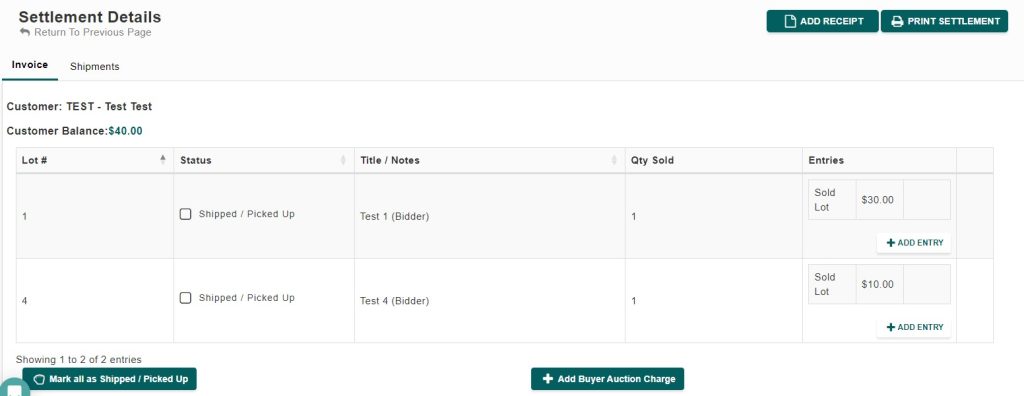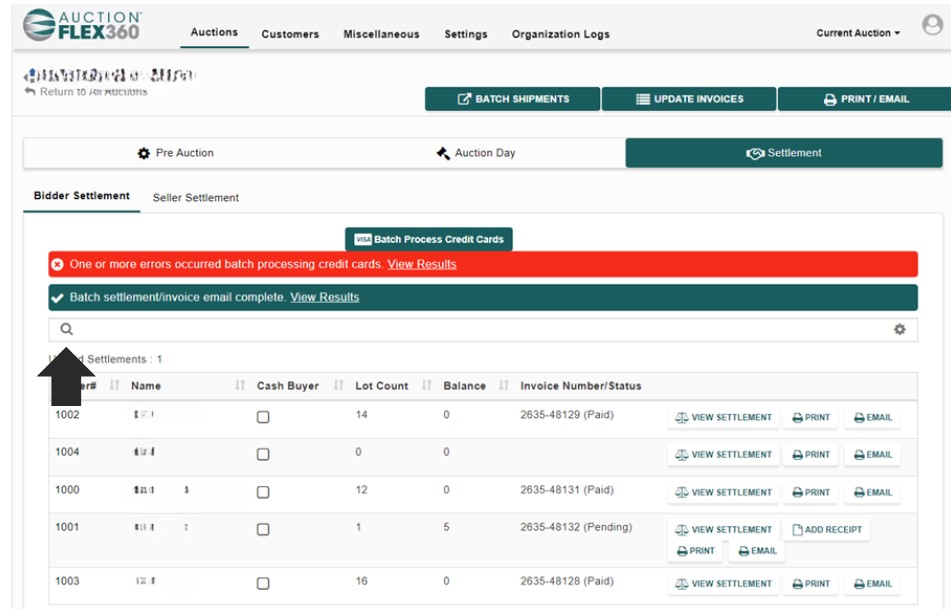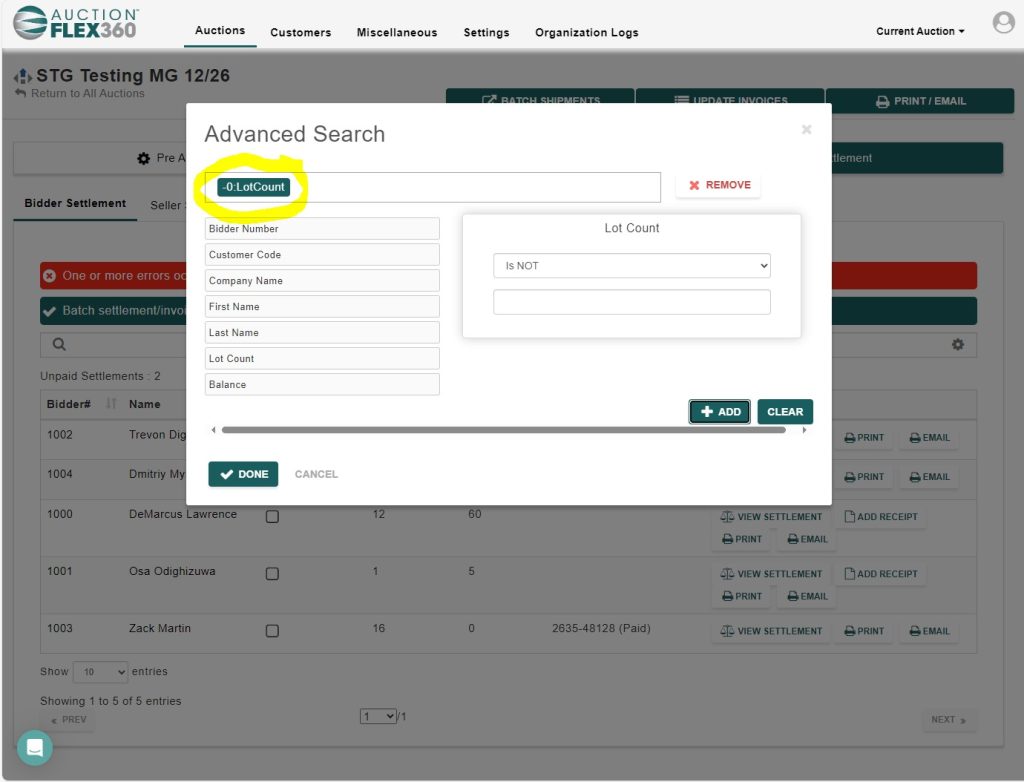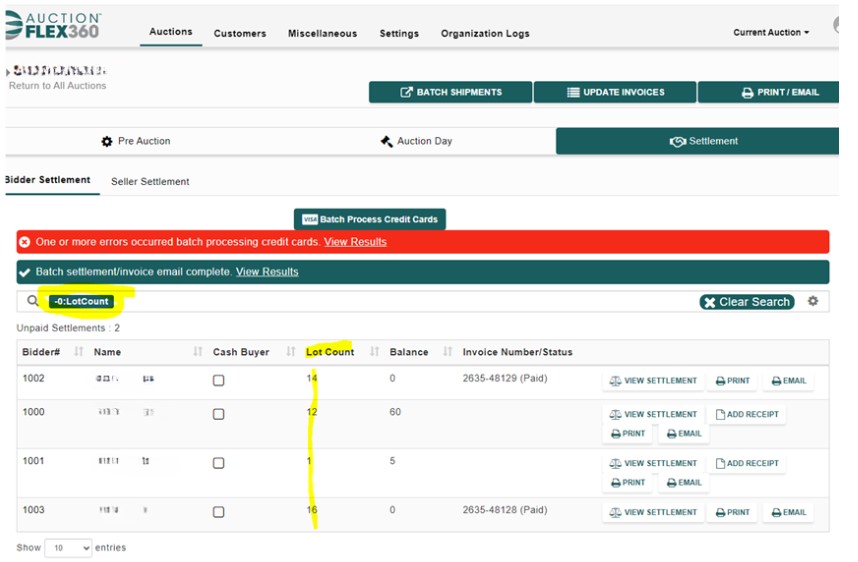Settlement
The Settlement section, located next to the Auction Day tab, allows you to efficiently manage and review all bidder and seller settlements. In this section, you can mark invoices as paid, add receipts, and send or email settlements, providing a streamlined way to handle post-auction processes.

- Batch Shipments: This option allows you to manage shipments in bulk, making it easier to organize and handle multiple shipments at once after an auction. It streamlines the process for shipping invoices, ensuring everything is processed efficiently.
- Update Invoices: This button enables you to update all invoices, which could include changes to payments, item quantities, or any additional fees or adjustments after the auction. It helps ensure that all invoices reflect the most accurate and up-to-date information.
- Print / Email: This function gives you the ability to either print or email invoices and settlements to bidders or sellers. It provides a convenient way to distribute the necessary documentation to participants in the auction.
Here’s an explanation of the elements shown in this image from AF360:

- Total Settlements/Unpaid Settlements: This section shows the number of settlements processed in total (3 in this case), with an indicator of how many are unpaid. In the image, all 3 settlements are unpaid.
- Bidder #: This column lists the bidder numbers associated with each participant. Bidder numbers help identify individual bidders in your auction records.
- Name: The name of the bidder, in this case, the “Test Test” names for illustration purposes. This is the buyer’s name associated with the settlement.
- Cash Buyer: This checkbox indicates whether the buyer is a cash buyer. If checked, it means the buyer paid or will pay in cash, often reflected in settlement options.
- Lot Count: This displays the number of lots (items) the bidder has won in the auction. Each bidder in this example has won two lots.
- Balance: This column shows the outstanding balance for each bidder that still needs to be paid.
- Invoice Number/Status: This column displays the invoice number associated with the settlement and its current status (unpaid, paid, etc.). In this case, no specific status details are shown.
- Shipping Requested: This indicates whether the buyer has requested shipping for their items. In this example, none of the buyers have requested shipping (“No”).
- View Settlement: Clicking this will allow you to view the detailed settlement information for the bidder, including items purchased, amounts due, and payment information.
- Print Settlement: This button enables you to print the settlement for physical records or to provide the buyer with a printed copy.
- Email Settlement: This allows you to email the settlement directly to the bidder, which includes the details of their purchases and any outstanding balance.
This layout gives you an organized view of bidder settlements and tools to manage them through viewing, printing, or emailing the necessary documentation.
Settlement Details

Here’s an explanation of the elements in this Settlement Details section from AF360:
- Add Receipt: Clicking this button enables you to add a receipt once payment has been made, ensuring the settlement reflects the completed payment.
- Print Settlement: This option allows you to print the settlement for your records or to provide a hard copy to the customer.
- Entries (Sold Lot): The “Entries” section details the final sale price for each lot. For example, Test Lot 1 sold for $30.00 and Test Lot 4 for $10.00, totaling the customer balance of $40.00.
- Add Entry: This button allows you to manually add additional entries, such as fees or adjustments, to the customer’s settlement for that specific lot.
- Mark all as Shipped / Picked Up: This button lets you mark all items in the customer’s invoice as “Shipped” or “Picked Up” in one action, saving time when handling multiple lots.
- Add Buyer Auction Charge: This button allows you to add extra charges, such as auction fees, to the customer’s settlement, which will be reflected in the total amount due.
This section helps streamline the settlement process by providing a clear overview of what was purchased, the status of items, and options for managing payments and shipping.
Sample Settlement Report:

Filtering Settlements:
You can easily filter the settlements table on the Settlements page and, once filtered, the Print/Email button will apply those filters to your selections. Here are a few examples of how you can use the filters:
- Filter by Settlements with a Balance: View only those with outstanding balances.
- Filter by Bidders Who Purchased in the Auction: Show only the bidders who made purchases.
Once you’ve applied a filter, it will stay active as you navigate between auctions, unless you clear your browser cache.
How to Filter:
- Start by clicking the magnifying glass on the search bar to open the Advanced Search.

- You can filter by Lot Count or Balance. If you want to send or print settlements for everyone who purchased something, select Lot Count. If you only want to see those who still owe, select Balance.

- After applying the filter, click Done, and you’ll see the results appear in the search bar.

Now, your list will be narrowed to show only the bidders who have at least one item in the auction.

Printing/Emailing Settlements:
Once filtered, clicking Print/Email will give you the option to either email the filtered bidders or send them invoices along with their settlements. For example, if your filtered list contains 4 bidders, you’ll see “4 settlements” in the dropdown. You can then choose to print or email based on your filtered results, leaving out those who didn’t qualify for the filter.

Explore Advanced Search:
The Advanced Search box offers many ways to filter your table. Feel free to experiment with different options! If you encounter any issues while emailing or printing invoices, please submit an issue resolution task, and we’ll take a look.

